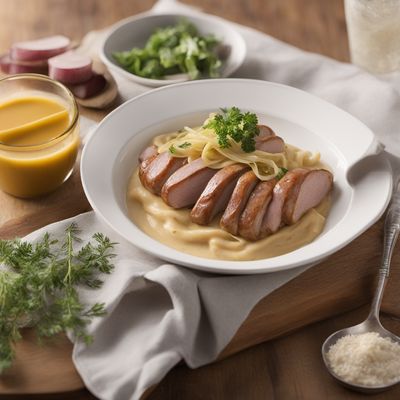
Ingredient
Knackwurst-type sausage
The German Delicacy
Knackwurst-type sausage is made from a mixture of ground pork, beef, and spices, such as garlic, nutmeg, and white pepper. It is characterized by its short and plump shape, often with a curved appearance. When cooked, it has a firm and slightly chewy texture, making it a popular choice for grilling or pan-frying.
Origins and history
Knackwurst-type sausage has its roots in German cuisine and is believed to have originated in the 16th century. It is closely associated with the region of Franconia, where it was traditionally made using a combination of pork, beef, and veal. Today, it is enjoyed throughout Germany and has gained popularity in other countries as well.
Nutritional information
Knackwurst-type sausage is a good source of protein and provides essential vitamins and minerals. However, it is relatively high in fat and sodium, so it should be consumed in moderation as part of a balanced diet.
Allergens
Knackwurst-type sausage may contain allergens such as wheat, soy, or milk, depending on the specific recipe and brand. Individuals with allergies or dietary restrictions should check the ingredient list before consuming.
How to select
When selecting Knackwurst-type sausage, look for sausages that are plump, well-shaped, and have a smooth and even texture. Avoid sausages that appear wrinkled, discolored, or have a strong odor. Fresh sausages should be refrigerated and consumed within a few days of purchase.
Storage recommendations
To maintain the freshness and quality of Knackwurst-type sausage, store it in the refrigerator at or below 40°F (4°C). If the sausage is uncooked, consume it within a few days. Cooked sausages can be stored for a longer period but should be consumed within a week. Freezing is also an option, but it may affect the texture of the sausage.
How to produce
Knackwurst-type sausage is typically produced by professional sausage makers using specialized equipment and techniques. However, adventurous home cooks can try making their own version using a meat grinder, sausage stuffer, and a traditional German sausage recipe. It requires some skill and patience, but the result is a homemade sausage that can be customized to personal preferences.
Preparation tips
Knackwurst-type sausage can be enjoyed in various ways. It is often grilled or pan-fried until crispy and served with sauerkraut, mustard, and a side of crusty bread. It can also be added to stews, soups, or casseroles for added flavor and heartiness.
Substitutions
Bratwurst or bockwurst can be used as substitutes for Knackwurst-type sausage, as they share similar flavors and textures. However, the distinctive snap and smoky flavor of Knackwurst may be difficult to replicate.
Culinary uses
Knackwurst-type sausage is commonly used in German cuisine, where it is a staple in dishes like currywurst (sausage with curry ketchup), sausages with sauerkraut, or served as part of a traditional German breakfast. It is also a popular choice for Oktoberfest celebrations and outdoor grilling events.
Availability
Knackwurst-type sausage is widely available in Germany and can be found in German delicatessens, butcher shops, and supermarkets. It is also available in some international markets and specialty food stores around the world.
More ingredients from this category
Recipes using Knackwurst-type sausage

German-Style Knockwurst with Sauerkraut and Mustard Sauce
Savory Sausage Delight: German-Style Knockwurst with Tangy Sauerkraut

German Plockwurst with Sauerkraut and Mustard Sauce
Savory Sausage Delight: German Plockwurst with Tangy Sauerkraut and Mustard Sauce

Kielbasa Burger
Sizzling Polish Sausage Burger

Knack d'Alsace - French Sausage and Sauerkraut Stew
Savory Delight: A French Twist on Sausage and Sauerkraut

Ukrainian-Style Sausage and Potato Stew
Hearty Sausage and Potato Delight: A Taste of Ukraine

German Sausage Delight
Savory Sausage Medley: A German Culinary Delight